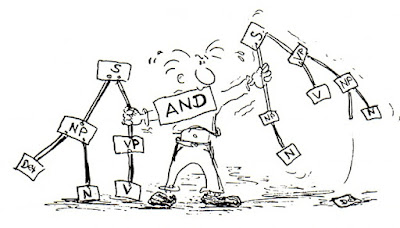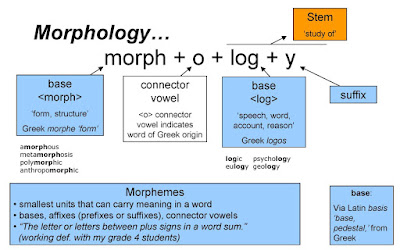Part of Pure Linguistics - Syntax
Assalamu’alaikum wr.wb
Hai hai ketemu lagi dengan Siti. Baiklah kali
ini Siti akan nge-post masih berkaitan dengan cabang daripada Linguistics
yaitu Syntax. Sebelum itu siti ada video nih buat readers, bisa di klik di sini !
Nah, bagaimana menurut readers setelah menonton video tsb? apakah jelas pembahasan tentang syntax nya atau tidak?? kalau begitu Siti akan menambahkan sedikit penjelasan tentang syntax yang referensinya dari e-book... ceck it out !
Syntax:
how words are grouped and ordered within sentences, clauses, and phrases. For
instance, English places adjectives before nouns (e.g. beautiful house)
rather than after them (*house beautiful ), a feature of English syntax
that distinguishes Germanic languages from Italic languages, which generally
favor the placement of adjectives after the nouns that they modify (e.g.
Italian casa bella ‘house beautiful’).
This
chapter marks a major transition in the book. It moves the discussion from a
focus on principles of pragmatics to a description of rules of grammar. In
other words, instead of describing why particular structures are used in
specific contexts, the discussion will focus more explicitly on how particular
constructions are formed. At the center of any discussion of syntax is the
notion of constituency: the idea that syntactic units are not simply
arbitrarily grouped and ordered but form identifiable units. Traditionally,
syntacticians have identified four different levels of structure at which
constituents can occur:
Sentences
à Clauses
à Phrases
à Words
à
Largest Smallest
The
largest constituent is the sentence; the smallest is the word. Between these
two extremes are clauses and phrases, though as will be demonstrated later,
sometimes sentences and clauses are identical: a declarative sentence, for
instance, may consist of one main clause. There are two different types
of constituents: immediate constituents and ultimate constituents. Exactly
which elements constitute immediate constituents depends upon what level of
structure (sentence, clause, phrase) is being considered. To illustrate this
point, consider the sentence below:
Robbin Mayfield and his
graffiti-removal crew drive an old Wonderbread truk
(ICE-USA
W2C-002)
The
kinds of criteria applied above to identify adjectives and subject complements
can be applied to all forms and functions in English. Such an analysis reveals
that constituents have forms at all four levels of structure:
Word
Classes :
noun, verb, adjective, adverb, preposition, etc.
Phrases :
noun phrase, verb phrase, adjective phrase, adverb phrase, prepositional phrase
Clauses :
main, dependent
Sentences :
declarative, interrogative, imperative, exclamatory
While
all types of phrases, clauses, and sentences are given in the list above, only
a sampling of word classes is given, since additional classes exist in English
(e.g. articles, pronouns, conjunctions). Thus, the functions below are often
referred to as clause functions:
Subject
Predicator
Complement (subject
and object)
Object (direct and
indirect)
Adverbial
Since
constituent forms and functions are key components of syntax, the next two
sections provide an overview of some of the important form classes in English
and the particular clause functions that these particular forms can have.
Baiklah
readers, sekian dulu pembahasan tentang Syntax, jadi Syntax itu membahas
tentang bagaimana kata dikombinasikan menjadi sebuah phrasa dan phrasa menjadi kalimat..
Introducing_English_Linguistics_Charles
F. Mayer
Thank you for join ^^ see U :)






Komentar
Posting Komentar
Life is short. There is no time to leave important words unsaid [Japanese Proverb]